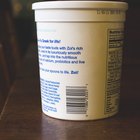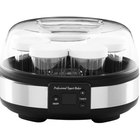
As a sour and fermented dairy product, it can be difficult to tell when yogurt has curdled. Checking the sell-by date on the yogurt container offers a clue as to your yogurt's age. Most yogurt manufactures guarantee their products quality seven days past this date, but its freshness depends on how the yogurt was stored. Yogurt can keep in the refrigerator for one to two weeks and in the freezer for one to two months. Once opened, sealing the yogurt in an airtight container keeps out the moisture and air-borne contaminants that hasten curdling.
Step 1
Dip a spoon into your yogurt container and gently stir the yogurt. Look for small, balls that look like cottage cheese, which indicate curdling. This usually happens first around the edges and along the bottom of the yogurt container.
Step 2
Feel for a rubbery resistance when you stir or press a spoon against the yogurt. Even if the yogurt doesn't look curdled, a change in the yogurt’s texture is a sign of spoilage. Good yogurt is soft, creamy and smooth.
Step 3
Scoop up some yogurt on your spoon, then tip the spoon, and watch how the yogurt drops back into the container. If the yogurt breaks apart as if falls from the spoon, and seems watery and runny, this is a sign of curdling. Fresh yogurt will slide off the spoon and keep its shape. The small amounts of liquid pooled on the surface of the yogurt is a beneficial byproduct called whey, and should be stirred back in before serving.
Step 4
Smell the yogurt to detect an acrid odor instead of a pleasantly sour one. If the yogurt is near the bottom of the container, it might be the container itself that smells bad. Transfer the yogurt to a smaller container and smell again. If you suspect your yogurt has curdled but aren’t certain, do not taste it. Instead, throw it out.
Related Articles

Why Does Greek Yogurt Have More Protein ...

How to Freeze Greek Yogurt
Does Sour Cream Go Bad if Unopened?

How to Tell When Orange Juice Has ...

How to Freeze Yogurt Sauce

What is Healthier: Greek Yogurt or ...
How to Save Homemade Yogurt That Didn't ...

How to Froth Milk With the Magic Bullet

How to Ferment Milk

How to Substitute Yogurt for Milk in ...

How to Sweeten Plain Yogurt

How to Use Buttermilk That Has Passed ...

Baking Substitutions for Ricotta Cheese

How to Determine the Authenticity of ...

How to Make Creme With Alpha Hydroxy ...

How to Change the Date on a Rolex

How Can I Tell If Ricotta Cheese Has ...

How to Mix Yogurt With Unflavored ...

Cooking Yogurt Without Curdling It

How to Remove the Back of a Movado Watch
References
Resources
Tips
- Though it makes a suitable base for sauces, yogurt curdles when it's cooked. Stabilize the yogurt first by stirring in a bit of flour -- such as whole-wheat or chickpea flour -- and choose high-fat versions of yogurt for cooking.
- Refrigerate yogurt within two hours of buying it. To keep your yogurt safe until lunch time, freeze a water bottle or juice box and pack together in an insulated lunch bag. The frozen liquid will serve as an ice pack and be thawed and ready to drink by the afternoon.
Warnings
- Yogurt that has been left out for more than two hours at room temperature -- and one hour in temperatures 90 degrees Fahrenheit and above -- may be unsafe to eat.
- The live and active cultures in yogurt prevent harmful mold from growing, but once these beneficial bacteria die off, mold can take over. Even a spot of mold on the container is a sign that your yogurt has spoiled. Throw away any moldy yogurt without tasting, even if part of the yogurt still appears good.
Writer Bio
For more than 10 years, Carol Butler has run a small, off-grid furniture business with her husband and is a regular contributor to the Edible community of magazines. As staff writer for RichLife Advisors, she covers financial planning and other industry-related topics. She holds a B.F.A. in theater arts.
Photo Credits
George Doyle/Stockbyte/Getty Images